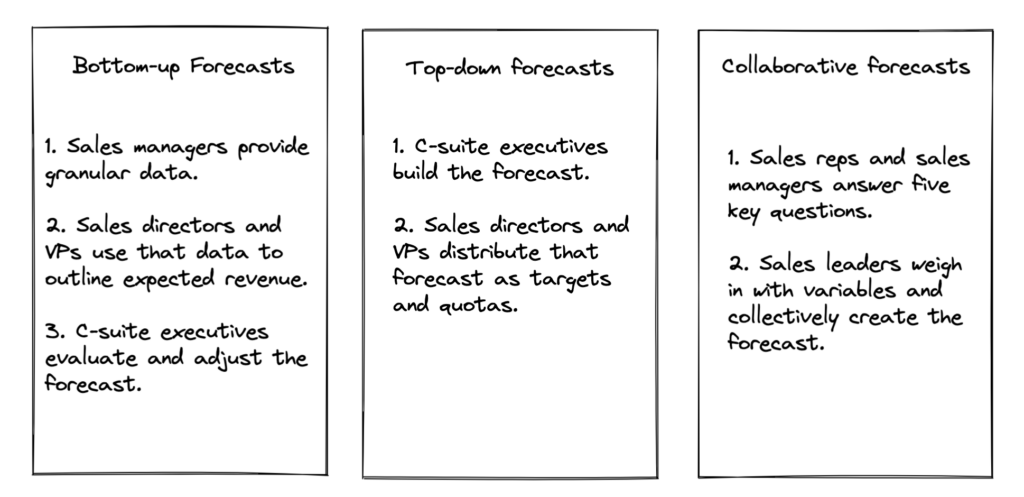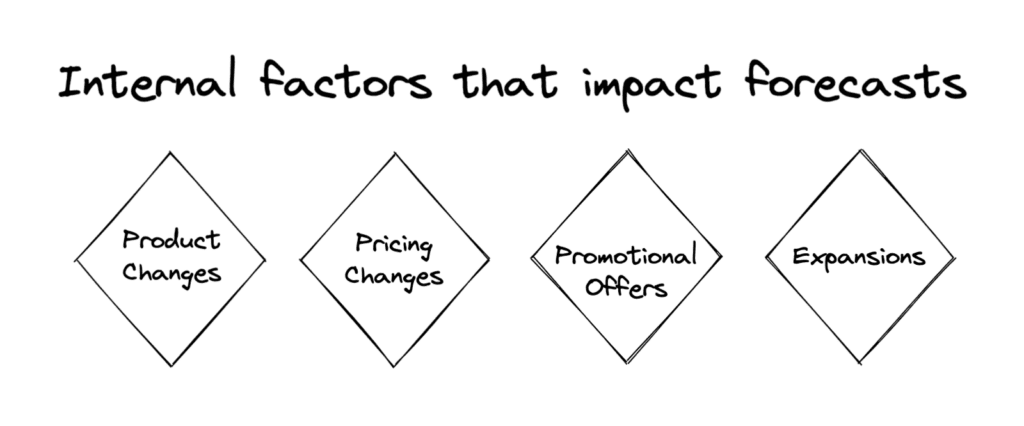“Look back twice as often as you look forward.”
“Ask reps to set aside two hours a day to add activity data to the CRM.”
“Don’t add volatile variables to your sales forecast.”
You’ve likely heard sales forecasting advice tossed around like confetti.
But when it comes time to sit down and actually build a dependable forecast, you don’t know where to begin. (Not your fault. We live in an era of information overload.)
That’s why we wanted to keep this guide as simple as possible. No fluff, just need-to-know information. And maybe a GIF or two.
This guide will cover:
- What exactly is sales forecasting?
- The value of sales forecasting
- Who is responsible for a sales forecast?
- Key elements of an effective forecast
- Factors that can affect your forecast
- Effective methods of sales forecasting
What exactly is sales forecasting?
Simply put, a sales forecast is a visualization of a company’s expected sales revenue.
Sales forecasting is the action of predicting how much you’ll sell in a given time period.
When forecasting, you’re looking to predict:
- Volume (how many deals you expect to close)
- Frequency (when you expect those deals to close) and
- Value (how much you expect each deal to be worth)


Sales forecasting used to be an art form. Reps would intuitively feel good about a deal and pop the champagne. More experienced reps would even be right sometimes. The people who built the forecast used reps’ self-reported activity data along with historical performance data.
But things have changed.
Today, sales forecasting is more science than art. With revenue intelligence, emotion AI technology, forecasting tools, and predictive sales platforms, sales forecasts have become more reliable.
The value of sales forecasting
OK, now it’s time for us to raise our arms to the heavens and give praise to the sales forecasting gods. No but
seriously, we can’t emphasize the importance of sales forecasting enough.
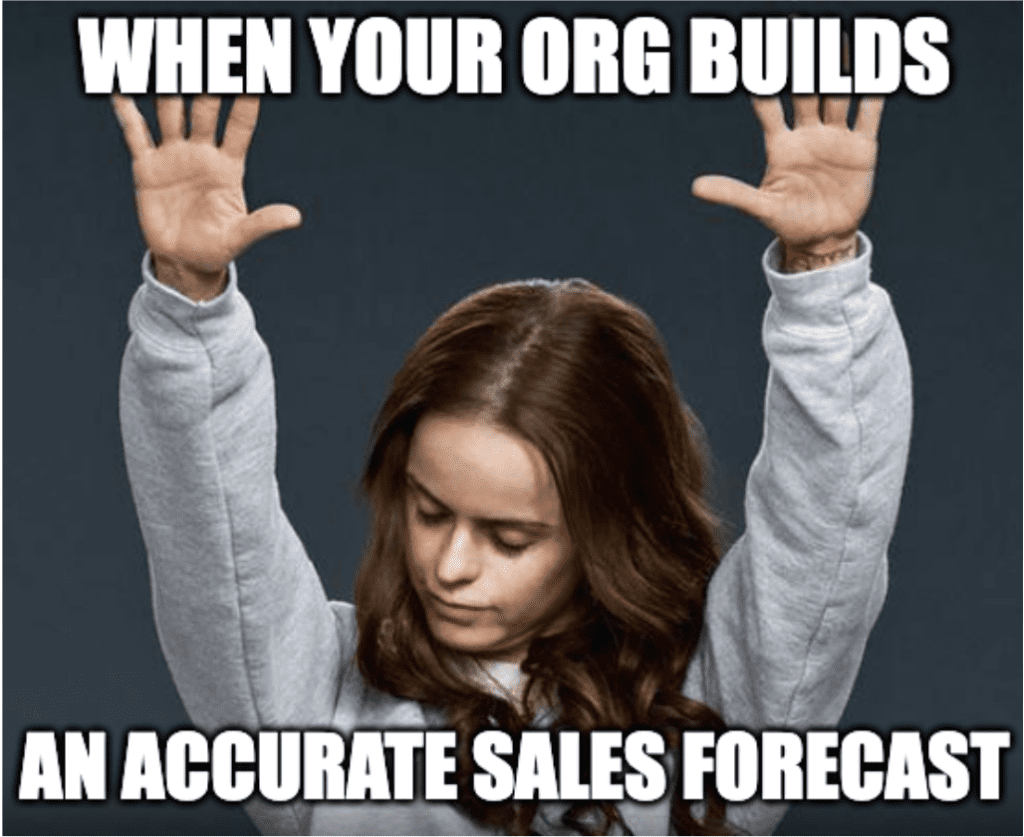
Sales forecasting has four tangible benefits:
Improved decision-making:
Sales forecasts can inform your decisions regarding marketing, sales, product, and hiring.
Let’s say you estimate X dollars in revenue from a product launch. If you build an exhaustive forecast, you’ll
know how many extra reps you need to sell the new product.Better goal setting
With an accurate forecast, you can set realistic goals. In other words you can invest, pivot, or
cut back with confidence. Say you’re launching a new product that will create an upsell opportunity with 60% of
existing accounts. If you do a forecasting exercise, you know how much of the anticipated revenue you can invest
into marketing the product launch.More accurate budgeting
Sales forecasting tells you how much money you can spend on your business.
Let’s say you plan a roadshow to generate leads. Historical forecasts can tell you when you’ll generate revenue
from the events. The forecast will factor in the time it takes for leads to warm up, as well as the time for
trials, proof of concepts (POCs), and negotiations.Empowered external operations
When you have a reliable sales forecast, you can confidently make decisions to grow the business through activities like fundraising, mergers, and acquisitions.
Let’s say you’ve achieved product market fit but have a small competitor. They sell an inexpensive plugin that
only does a fourth of what your product does — but some of your prospects only need that. An accurate forecasting
exercise can tell you whether you’ll have an option of buying them out.
Who is responsible for sales forecasting and why?
Interestingly, only 20% of sales leaders say they’re satisfied with their sales forecasting process. This could be due to lack of clear ownership or a systemic glitch. In either case, let’s understand who does what, so your processes can be improved.
Rarely is forecasting done by a single person or team. It’s a tiered responsibility.
From board members to sales reps, there are usually a few different stakeholders involved with building a forecast. Here’s the role each person plays in bottom-up, top-down, and collaborative forecasts:
Bottom-up forecasts
First, sales managers provide granular data. Second, Directors of Sales or VPs of Sales outline the expected revenue based on this data. Third, members of the C-Suite evaluate and adjust the forecast.
While each of these people performs the same exercise, the information they’re privy to is different.
For example, the sales manager might know which of their reps are at the finish line with important deals. A VP of sales might have a pulse on multiple teams and can gauge the accuracy of forecasts. C-Suite executives might have confidential information on acquisitions, which might drastically change the forecast.
Top-down forecasts:
Some businesses take a top-down approach. CFOs, CROs, COOs, and CEOs (and sometimes even board members) are responsible for the forecast as they know the numbers needed to meet business goals.
This forecast is handed down to the Directors of Sales and VPs of Sales to distribute as targets and quotas.
Collaborative forecasts:
In a collaborative sales forecast approach, reps and managers answer five questions:
- What does the board want?
- What builds the pipeline?
- What are the granular details reps are working on?
- What are the gaps? Where is the difference?
- Do I need to make better forecasts?
Then they ask executives to weigh in with variables and collectively create a final forecast. (More on exact forecasting methods later).
Key elements of effective sales forecasting
At the highest level, there are three key elements of an effective sales forecast. (We describe these in detail in our blog titled “Can you improve sales forecast accuracy by analyzing emotional insights?”)
-
High-quality CRM data
Humor us with a baking analogy. If you use expired flour and rotten eggs, your cake is going to taste horrible. The same logic applies to forecasting. If your sales activity data is incomplete or inaccurate, your forecast is going to be horrible … horribly inaccurate.
-
Emotional insights
Buyer sentiment and buyer engagement help you understand how likely a deal is to close. Collectively, we call these emotional insights. Most companies don’t factor emotional insights into their forecast, which is a huge missed opportunity.
When you add emotional insights to the mix, you operate at the next level. It’s sales forecasting 2.0.
-
High-quality forecasting method
There are different sales forecasting techniques. (Four are described below.) Similar to our above example where bad data equals a bad forecast, a bad forecast method equals a bad forecast, too.
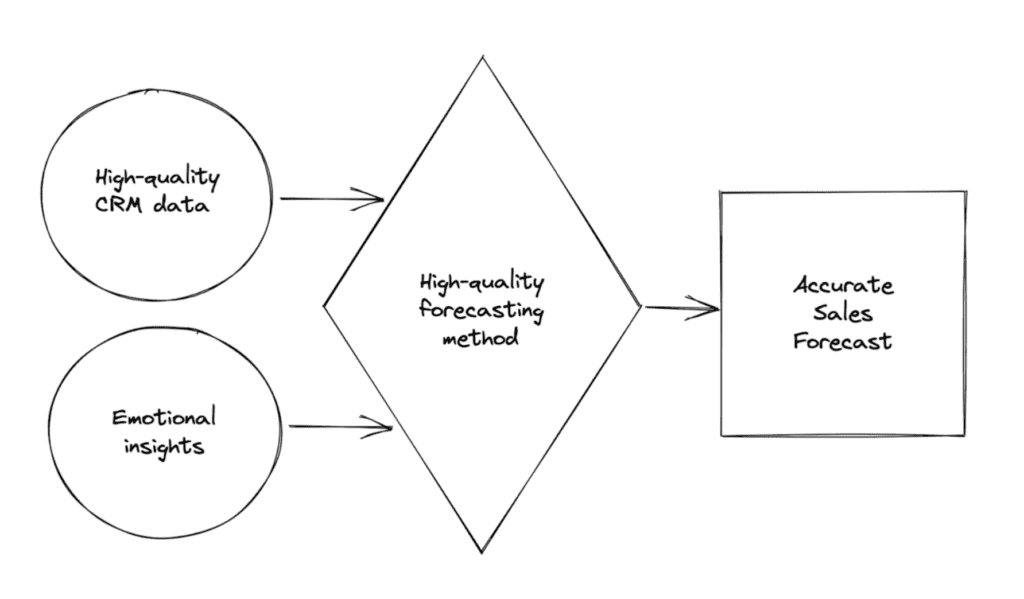

Cross functional alignment
Daniel Nackovski, the former VP of Sales at Certainly and inRiver, says, “Building the forecast is a 360 exercise involving the entire organization. It needs:
- Sales teams to pitch in with pipelines,
- Customer success teams for data on upselling,
- Marketing to generate demand and create leads, and
- Product teams to build features that will bring in more revenue.
If any of the teams decide something by themselves without buy-in from the rest of the organization, the forecast might be inaccurate.”
Improve your sales forecast accuracy with this 2 x 2 matrix.
Factors that can affect your sales forecast
First, let’s look internally.
Product changes
Does your product roadmap have you releasing new products? Or dramatically changing your current product offers? New products might not sell as quickly, extending your sales cycle.
Pricing changes
New year, new pricing? Or changing your pricing to keep up with competitors? Pricing changes will impact your forecast.
Promotional offers
Don’t forget to factor in promotions. Especially in a quarter that contains several holidays, promotions can impact your numbers.
Expansions
Are you launching a new partner network? Opening a new office? Expanding into a new territory? All of these must be considered.
External factors impact sales, too. These include:
Economic downturns
To evaluate what a downturn means for you, ask, how does this downturn affect our industry and product? Typically, sales slow down, clients churn, negotiations take longer, and forecasts become more conservative. That’s because customers have less disposable income and lower risk appetites.
But this isn’t true for all industries. Some companies even benefit in a downturn. Take Zoom during the pandemic.
The key to forecasting during an economic slump? Historical trends.
“Look at historical trends to understand how an economic shift will play out. The more similar, the better. There are always patterns and recurrences of the same theme over eight to ten years.”
Travis Batiza, Client Executive, Q for Sales by Uniphore
During a downturn, your sales forecast depends on your product’s must-have features and your ability to pivot. For example, when COVID created mandatory stay-at-home orders, Spartan Race pivoted from an event-based company to a content machine. Had they lacked that change agility, their forecast would look a lot different. (And not in a good way.)
Product-market fit
If your company hasn’t yet found product-market fit, forecasting can feel harder than a big ol’ lump of concrete. You simply don’t have as much historical data to lean on.
And if you’re a very early-stage company, you may not know exactly where your point of conversion is.
Regulation changes
Regulation changes impact sales. For example, passing of the GDPR created stricter data policies, not only in the EU but in the U.S., too.
If you sell data protection software or services, this is good for your bottom line. But if your business is about selling personal data, you’re probably going to take a hit.
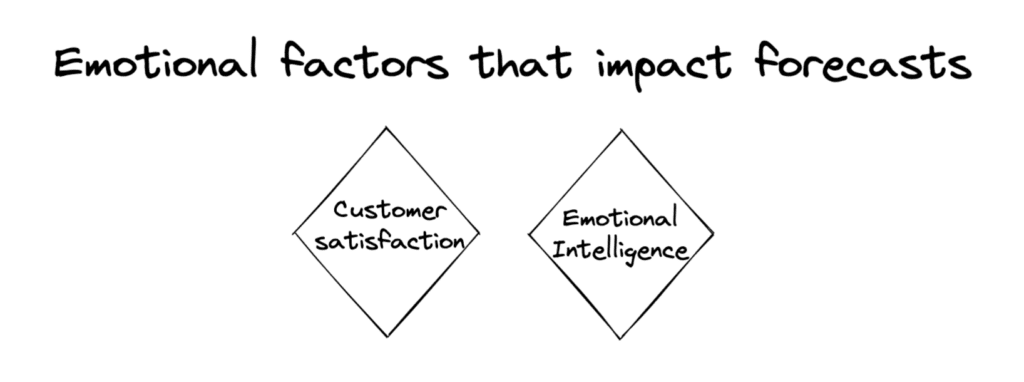

In addition to internal and external factors, there’s a third category that can impact sales forecasts: Emotional Factors.
Customer satisfaction
When’s the last time you reviewed your NPS score? If your customer satisfaction rate has dropped or increased recently, it might impact your forecast. Wondering why?
Happy customers talk about your brand, and you get more sales through word of mouth.
Unhappy customers talk about your brand, too (unfortunately).
Pro tip
Get a better grip on which deals will close—and when—by analyzing emotional insights (buyer engagement and sentiment) across all deals.
Emotional Intelligence (of your sales reps)
Ninety-five percent of buying decisions are driven by our emotions. The better your sales org can read prospective buyer cues (like word choice, tone of voice, and body language), the better they can respond appropriately.
Emotional Intelligence, or “EQ,” plays a huge role in selling success. If recently hired a bunch of new reps who knock it out of the park in terms of empathy, good listening, self-awareness, they can impact your forecast for the better.
Effective methods of sales forecasting
OK, now it’s time to get into the fun stuff: how to forecast sales and create accurate sales forecasts. If you dig details and numbers, this section is going to be your jam.
Remember, calculating a sales forecast is about predicting how much you’ll sell within a given time period (a month, quarter, or year).
But regardless of the time period you’re working within, all forecasts start at the same point: looking at your pipeline and estimating close rates for opportunities.
Most sales leaders take a scenario approach — estimating numbers across three levels:
Pessimistic: if you perform worse than expected.
Realistic: if everything develops as we expect.
Optimistic: if everything goes as planned and then something magical happens on top of it. (For example, if you move into a new territory and it explodes.)
To estimate the numbers for these scenarios, sales leaders commonly use four sales forecasting methods:
- Historical Forecasting
- Opportunity Stage Forecasting
- Length of Sales Cycle forecasting
- Multivariable Analysis
Let’s dig into each of these.
Historical Forecasting
No matter what you’re selling, you’re probably practicing some form of historical forecasting. It’s as simple as thinking, “how much did we sell last Q4?” and then using the answer to inform this year’s Q4 estimate.
Because it’s so simplistic, historical forecasting is just one of several sales forecasting methods you’d use.
Opportunity Stage Forecasting
Opportunity sales forecasts look at where in the pipeline the deal is. Reps and sales managers use this information to forecast the revenue from each deal multiplied by its probability of closing.
For example, you might have only a 5% chance of closing a lead in the prospecting stage but a 60% chance of closing a lead in the negotiation stage.
Let’s try this with an exercise by assigning a close probability to each stage:
| Stage | Probability of closing |
|---|---|
| Prospecting | 5% |
| Qualification | 15% |
| Proposal | 30% |
| Negotiation | 60% |
| Closing | 90% |
Now you can multiply the probability by the total revenue in each stage.
Example: $10M x .05 = $500,000
| Stage | Probability of closing | Revenue | Total Revenue |
|---|---|---|---|
| Prospecting | 5% | $10M | $500,000 |
| Qualification | 15% | $2M | $300,000 |
| Proposal | 30% | $2M | $600,000 |
| Negotiation | 60% | $1.5M | $900,000 |
| Closing | 90% | $1M | $900,000 |
| Total | $3.2M |
As you can see, opportunity stage forecasting is one of the simplest sales forecasting methods. But it has three drawbacks:
One, it assumes the probability of closing to be constant, which is rarely the case. In an economic downturn, even deals in the closing stage might not go through.
Two, it doesn’t factor in the historical ebb and flow of deals. For example, companies might set budgets in Q4 to be able to make purchase decisions in Q1. Because of that, deals would be more likely to close in Q1 when stakeholders know their exact budgets.
Three, it does not tap into the emotional pulse of the decision-maker. A highly engaged prospect in the proposal stage may be more likely to close than a disengaged prospect in the negotiation phase. (Again, understanding buyer sentiment and engagement for each deal helps a lot here.)
The takeaway: opportunity sales forecasting is an option for when you need quick napkin math to explain the numbers to someone, and it’s OK as a starting point. But we wouldn’t recommend using it as your only forecasting method.
Length Of Sales Cycle Forecasting
Length of sales cycle forecasting is exactly what it sounds like. The forecast considers how long a deal has been in the pipeline.
If you’re selling an enterprise solution, your sales cycles might be 8-12 months long. But if you’re selling a less expensive solution, your sales cycles might be 30-45 days.
Assign deals a likelihood of closing based on industry and category norms.
Let’s try this with an exercise.
Say your average sales cycle is 90 days. On average, deals are most likely to close midway through that cycle (between 45-70 days).
| Time period | Likelihood of closing |
|---|---|
| Over 90 days | 10% |
| 70-90 days | 30% |
| 45-70 days | 40% |
| 30-45 days | 30% |
| 0-30 days | 20% |
Now we’ll add up the total ACV of all deals in each category and multiply that number by their likelihood of closing to get our forecast.
Example: $1M x .1 = $100,000
| Time period | Likelihood of closing | Revenue from deals | Total Revenue from stage |
|---|---|---|---|
| Over 90 days | 10% | $1M | $100,000 |
| 70-90 days | 30% | $2M | $600,000 |
| 45-70 days | 40% | $2M | $800,000 |
| 30-45 days | 30% | $4M | $1.2M |
| 0-30 days | 20% | $1.5M | $300,000 |
| Sales forecast | $3M |
Use a Length of the Sales Cycle Forecast method to inform your forecasts but not as a standalone method. We also recommend that you periodically revisit and update your average sales cycles, factoring in market conditions when doing so.
Multivariable Analysis
Multivariable forecasts are the real MVPs. They’re also the most complex. They combine predictive analysis and elements from other sales forecasting methods:
- Historical forecasting
- Opportunity stage forecasting
- Length of sales cycle forecasting
When you’re just starting out, you’re probably not going to begin with a complex multivariable analysis. That’s OK. Start simple, and build from there.
Try it out: collecting emotional insights
No matter which forecasting method you use, the sooner you can incorporate emotional insights, the better. Emotional insights help you to get a real-time pulse on deals across your sales org. Try it out: complete this 2×2 buyer sentiment and engagement matrix.

